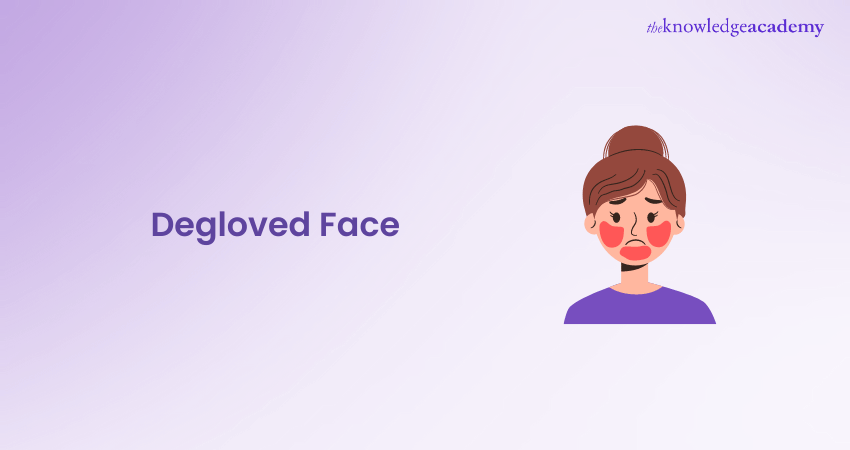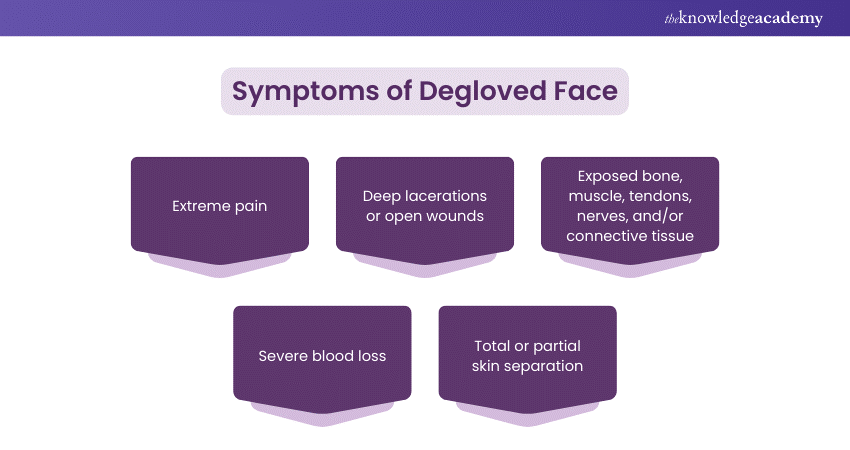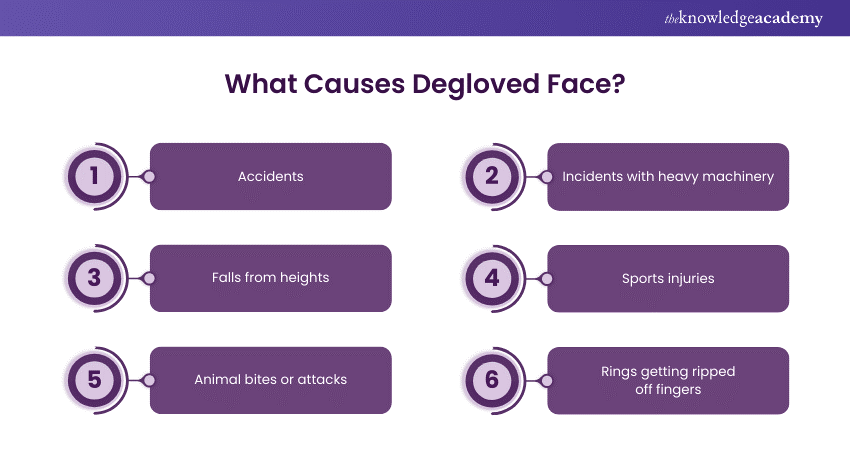We may not have the course you’re looking for. If you enquire or give us a call on +60 1800812339 and speak to our training experts, we may still be able to help with your training requirements.
Training Outcomes Within Your Budget!
We ensure quality, budget-alignment, and timely delivery by our expert instructors.

Imagine a sudden, jarring impact—whether from a car crash, a workplace mishap, or an unexpected encounter with an animal. In that moment, the delicate skin and tissues of your face are violently torn away from the underlying skull. This is what we call a Degloved Face injury—a name that itself sends shivers down the spine. But fear not!
In this comprehensive blog, we’ll explore what a Degloved Face really is, explore treatment options, and discover the path to recovery. Buckle up, because we’re about to navigate a tough situation with resilience and knowledge.
Table of Content
1) What is Degloved Face
2) Key Statistics on Degloved Face Injuries
3) Types of Degloving Injuries
4) Symptoms of Degloved Face
5) What causes Degloved Face or Degloving Injuries?
6) How is a Degloved Face or Degloving Injury treated?
7) Challenges Encountered in Treating Degloved Face and Degloving Injuries
8) Conclusion
What is a Degloved Face?
A Degloved Face, also known as an avulsion injury, is a severe and traumatic condition. It occurs when the top layers of skin and tissue are torn away from the underlying muscle, connective tissue, or bone, severing their blood supply. Degloving injuries can happen due to accidents like car crashes, falls, or industrial incidents.
In a Degloved Injury, the skin is stripped back from the affected area like a glove. These injuries can be superficial or dangerously deep, affecting underlying layers. They often result in serious long-term effects and require immediate medical attention. Even if the skin remains attached as a flap, it can lose its blood supply. Prompt treatment is crucial for effective recovery.
Key Statistics on Degloved Face Injuries
Degloved Face injuries, a severe type of trauma often resulting from high-impact incidents, require careful management and treatment. Below are some vital statistics and information derived from recent studies:
|
Patient type |
Males |
|
Percent |
91% |
|
Age |
18 - 50 Years |
|
Reasons |
Traffic Related Injuries |
|
degloving injury closure |
62.90% |
|
Mortality Rate |
9% |
Types of Degloving Injuries
There are mainly two types of Degloving. They are known as open Degloving and closed Degloving.
1) Open Degloving
Open Degloving typically occurs when your skin and tissue are ripped away, exposing your muscle, bone, or connective tissue. In many cases, the skin might still be attached partially as a flap near the wound. Open Degloving Injuries are mostly caused by:
a) Accidents with industrial or farm equipment
b) Falls from heights
c) Animal bites
d) Traffic accidents
e) Sports injuries
The most common body areas where Open Degloving Injuries can happen are the torso, legs, face and scalp. However, they can affect any of your body parts, including the fingers, arms, or feet. These types of Injuries are serious, and they require immediate care to reduce blood loss and prevent various infections.
2) Closed Degloving
Closed Degloving Injuries might not look serious because you can't always see them. Sometimes, the only sign is a bruise. These injuries happen when the top layer of skin and tissue gets separated from the deeper tissues, creating a pocket under the skin. This pocket, known as a Morel-Lavallée lesion, can fill up with lymph fluid, blood, and fat.
These injuries usually occur from the same kinds of accidents as Open Degloving Injuries. Closed Degloving Injuries often happen around the top of the hip bone, known as the greater trochanter. Other common areas include the:
a) Torso
b) Buttocks
c) Lower spine
d) Shoulder blades
e) Knees
Doctors often use an MRI scan to diagnose these injuries because it can spot the Morel-Lavallée lesions.
Equip yourself with essential risk management skills through our IOSH Managing Safely course.
Symptoms of Degloved Face
Your symptoms will depend on whether you have a closed or open Degloving Injury and how severe it is. Common symptoms of Open Degloving Injuries include:

a) Extreme pain
b) Deep lacerations or open wounds
c) Exposed bone, muscle, tendons, nerves, and/or connective tissue
d) Severe blood loss
e) Total or partial skin separation
f) Tissue death
g) Shock
Symptoms of closed Degloving Injuries include:
a) Pain
b) Bruising and skin discoloration
c) Swelling
d) Tenderness
e) Dry, cracked skin
Get globally recognised qualifications to excel in Workplace Safety and Risk Management with our NEBOSH Courses. Register now!
What Causes Degloved Face or Degloving Injuries?

Any part of your body with skin can get degloved. This often happens during high-energy accidents. For example, if your long hair gets caught in a conveyor belt, it could violently rip the skin and soft tissue from your skull and underlying muscles. This is one way you could end up with a Degloved Face, but these injuries most commonly affect the hands, feet, legs, and arms.
Another way this can happen is if a tyre runs over your foot. The intense pressure from the tyre, especially if you try to pull your foot out or if the tyre drags over it, can peel off your skin and soft tissue, leaving a degloved foot. What Causes Degloved Face?
Degloving Injuries are typically caused by:
a) Car, cycling, or motorcycle accidents
b) Incidents with heavy machinery like farm equipment or conveyor belts
c) Falls from heights
d) Sports injuries
e) Animal bites or attacks
f) Rings getting ripped off fingers
Be a leader and enhance Workplace Safety confidently with our NEBOSH HSE Certificate in Health and Safety Leadership Excellence Training. Join today!
How to Diagnose Degloved Face or Degloving Injuries?
Degloving injuries are diagnosed by doctors through a thorough medical examination and a detailed history of the injury. They may order tests to determine the extent of the damage. While open degloving injuries can appear dramatic and obvious, assessing the full extent of a degloved area can be challenging.
Visually examining the degloved skin might not reveal the full extent of the underlying damage. Skin viability can be difficult to assess using subjective criteria like bleeding, skin colour, temperature, and pressure response.
Open Degloving:
Open degloving injuries are easier to diagnose than closed degloving injuries because the muscle and bone may be exposed where the skin has been torn away. These open wounds, where the skin is degloved, can be closely evaluated visually, often under anaesthesia.
Closed Degloving Injuries:
In Closed Degloving Injuries, it may not be immediately obvious that the top layer of skin has degloved from the deeper tissue layers. The affected area may appear swollen or bruised.
If a Closed Degloving Injury is suspected, the physician may use needle aspiration to check for accumulated blood and fluid. Ultrasound, CT, and MRI tests may also be required to diagnose the extent of the Degloved Injury.
How is a Degloved Face or Degloving Injury Treated?
Treatment for a Degloving Injury depends on what kind it is, how severe it is, and where it is on the body. These injuries often come with other serious injuries like broken bones that need quick treatment. Also, not all emergency centres can handle complex skin repairs because they require special skills.
1) Open Degloving Injuries
The treatment for Open Degloving Injuries varies based on how bad the injury is and what resources the hospital has. Not every emergency room can do complex skin repairs, so you might need to go to a trauma centre that can offer more advanced care. Treatment options might include:
a) Reattaching the skin
b) Using skin from other parts of your body for skin grafts
c) Reattaching a finger or toe
d) Amputation
e) These treatments often need several surgeries. You might have to stay in the hospital for days or weeks and might need physical therapy to help you use the injured part again. Sometimes, a small Degloving Injury might just need thorough cleaning and bandaging.
2) Closed Degloving Injuries
Treatment for closed Degloving Injuries also varies by the injury's severity. For minor cases, you might just need compression bandages, physical therapy, and rest. For more serious cases, treatments might include:
a) Draining any fluid that has built up
b) Removing dead tissue
c) Sclerotherapy is a procedure in which medication is injected into your blood vessels to make them shrink.
Challenges Encountered in Treating Degloved Face and Degloving Injuries
If you have a Degloving Injury, you could expect various long-term effects depending on how serious your injury is. You’ll likely have a scar or some trace of your injury. You may face a long healing process that requires physical therapy and rehabilitation, plus regular aftercare from your doctor. You may even lose the function of the body part you injured.
Early treatment is important for Degloving Injuries. But even with that, you can still have complications. Some long-term effects of Degloving Injuries include:
a) Infection
b) Compartment syndrome (painful pressure buildup in your muscles)
c) Osteomyelitis (infection of your bone)
d) Lymphedema (buildup of lymph fluid under your skin)
e) Contracture (shortening and hardening of your muscles)
f) Nerve damage
g) Death
Ensure a safer workplace environment with our comprehensive Health & Safety in the Workplace Courses.
Conclusion
Degloving Injuries are serious and sometimes fatal. Early treatment is key to preventing infections. Treatment usually needs an extended stay at the hospital and several surgeries, followed by several months of physical therapy. We hope this blog has helped you get a clear idea about Degloved Face.
Learn more about Workplace Health and Safety regulations with our Best Practice in Occupational Health and Safety Regulation Training.
Frequently Asked Questions

Yes, you can live with a Degloved Face, but it requires immediate medical attention and ongoing treatment. Recovery can involve surgeries and rehabilitation to manage both physical appearance and functional outcomes.

The healing time for a Degloving Injury varies depending on its severity and the affected body part. Minor injuries or wounds may heal within a few days or weeks, while severe cases might take months or even require multiple surgeries to fully recover.

The Knowledge Academy takes global learning to new heights, offering over 30,000 online courses across 490+ locations in 220 countries. This expansive reach ensures accessibility and convenience for learners worldwide.
Alongside our diverse Online Course Catalogue, encompassing 17 major categories, we go the extra mile by providing a plethora of free educational Online Resources like News updates, Blogs, videos, webinars, and interview questions. Tailoring learning experiences further, professionals can maximise value with customisable Course Bundles of TKA.

The Knowledge Academy’s Knowledge Pass, a prepaid voucher, adds another layer of flexibility, allowing course bookings over a 12-month period. Join us on a journey where education knows no bounds.

The Knowledge Academy offers various IOSH Courses, including the IOSH Managing Safely Course and the IOSH Working Safely Course. These courses cater to different skill levels, providing comprehensive insights into the Importance of Health and Safety.
Our Health & Safety Blogs cover a range of topics related to Workplace Safety, offering valuable resources, best practices, and industry insights. Whether you are a beginner or looking to advance your Workplace Safety skills, The Knowledge Academy's diverse courses and informative blogs have you covered.
Upcoming Health & Safety Resources Batches & Dates
Date
 IOSH Managing Safely Course
IOSH Managing Safely Course
Mon 21st Oct 2024
Mon 20th Jan 2025
Mon 7th Apr 2025
Mon 16th Jun 2025
Mon 15th Sep 2025







 Top Rated Course
Top Rated Course



 If you wish to make any changes to your course, please
If you wish to make any changes to your course, please


